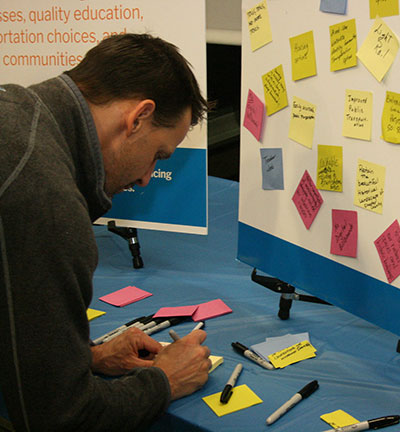
Getting everyone working toward common goals is a key component of main street organization.
How it Works
"Main street organization" involves getting everyone working toward common goals. The formula of an organizational structure of board and committees assisting professional management can ease the difficult work of building consensus and cooperation among the varied groups that have a stake in a main street.
While businesses, buildings, and infrastructure form the foundation of a main street, a dedicated group of individuals can help the main street to further flourish. This group can be a formal organization such as a Business Improvement District (BID), business association, or main street organization; a volunteer committee; or a municipal led effort either in the form of a committee or staff. The group can guide and implement promotional, economic, and design activities for the main street. Municipalities can choose to lead the main street group, partner with existing groups, or develop an external group to carry out main street activities. Municipalities can support main street organizations by including strategies in plans, providing leadership, and providing funding.
Organization is a key component of an overarching main street program, along with design, economic vitality, and promotion.
Benefits
Collaboration and Inclusion
A guiding organization can unify community stakeholders and provide opportunities for creating consensus, prioritization, messaging, cost sharing, and capacity building.
Unified Vision
Having a guiding organization creates a path forward and helps keep entities and individuals moving in the same direction.
Prioritized Implementation
A guiding organization will help prioritize initiatives and direct spending.
Sense of Place
A guiding organization can help to create a cohesive sense of place through design and promotional materials.
Funding
A guiding organization can raise and distribute funds, and seek grant funding.
Point of Contact
A main street organization can provide a clear point of contact for visitors, residents, and businesses regarding the main street.
Municipal Coordination
A main street organization can help to facilitate coordination between municipalities and local businesses.
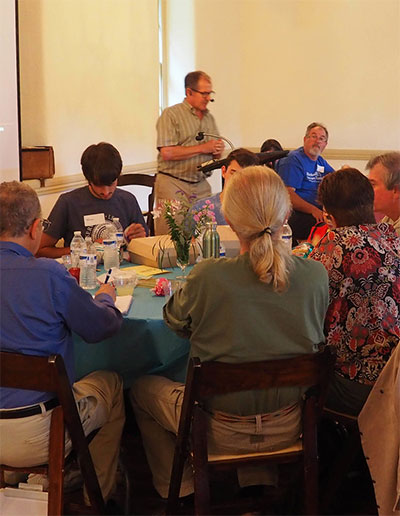
A main street organization can create a strong foundation for sustained economic success by cultivating partnerships, encouraging community involvement, and providing resources for the district.
Get Started
A group seeking to better organize their main street or a municipality should begin by identifying any formal or informal groups associated with a main street area and understanding their roles and responsibilities. These groups could include municipal staff, municipal committees, historical societies, business associations, Business Improvement Districts (BIDS), resident groups, realtors, and individual businesses. Next, additional main street activities that are desired should be identified and the capacity of current groups in undertaking these responsibilities should be analyzed. If capacity is not present, the work first must focus on generating this capacity within the municipal government or with a volunteer or business supported group.
Municipalities can support an existing main street organization or the creation of a new one through inclusion of recommendations and strategies in planning documents such as comprehensive, revitalization, or economic development plans. Municipalities can also provide funding, staff time, or resources.
Creating a new independent organization requires the creation of a leadership structure in the form of a board. With appropriate funding or capacity, committees and staff can be added to the organization. A vision for the organization should be developed, along with a strategic plan and actions that detail priority, timeframe, cost, and responsible entity. Municipal plans can provide guidance and background information. The plan should be completed after community outreach, which could include surveys or public meetings. A policy handbook will further strengthen the organization.
A leadership board should oversee the general mission of the organization, while committees can be responsible for specific sub-tasks such as promotion, cleaning, or safety. When considering recruitment of board or committee members (either for a municipal committee or an external organization) the ability to devote time, skills, expertise, connections, or funding while representing the community should be a priorty. Potential members may be municipal leaders, municipal staff, local business owners, property owners, developers, employees, residents, realtors, bankers, and representatives of other organizations. Board membership should include racial, gender, income, and age diversity that represents the community as a whole.
Paid staff can help ensure the organization runs smoothly, which could include an executive director, marketing staff, and accountant. These roles can be part- or full-time jobs or contracted out. If the funding is available, and the need is great enough, the organization may require additional staff including safety staff, volunteer coordinators, a business liaison, business recruiter, or others as needed.
Volunteers can be utilized for various activities, such as special events. Organizations should seek to compensate volunteers for their time through items such as free entry, food, or allowing volunteers to collect tips for their organizations at the event. Utilizing volunteers can require significant oversight and training.
Main street organizations will have numerous expenses. An operating budget for the main street organization will need to be developed including all expenses related to staff, office materials, technology, building or office space, events, printing, mailing, and other implementation costs. A funding structure will need to be identified and can be generated from any combination of the following:
- Business Improvement District (BID)
A BID implements a special property tax in addition to the municipal tax. The revenue from this tax goes to support the BID. The Pennsylvania General Assembly 2000 Act 130 regulates the creation and organization of BIDs. Municipalities can establish the area and organization for a BID. If less than 40% of property owners file disapproval for the creation of the BID, then the BID is established. Although a municipality must initiate the creation of a BID, residents or businesses can petition a municipality for BID creation. Additionally, if an established organization operating on the main street desires to run the BID, the municipality must allow this unless 40% or more of businesses file disagreement. - Event Revenue
Main street organizations can generate funding at events through ticket and merchandise sales. - Grants
Grant funding may be available for certain main street activities. The most common main street grants in Pennsylvania are provided through the Pennsylvania Department of Community and Economic Development, Keystone Communities Program. - Membership Dues
If a main street organization is organized as a business association, they can receive funding through membership dues. - Sponsorship and Public/Private Partnerships
Main street organizations can receive sponsorship from private organizations. - General Fund
Municipalities can designate general funds toward main street organizations. - Tax Increment Finance District (TIF)
Municipalities can opt to create a TIF district on a main street that is within a redevelopment area. TIF districts should only be created where development would not occur but for funding provided through the TIF. The Equalized Assessed Value (EAV) of the district at the time of the TIF creation is set as a base value, and all taxing bodies will continue to receive base value taxes throughout the life of the TIF. When new development increases the EAV, the new taxes will go to the TIF to implement certain activities. After the TIF ends (a district shall not exceed 20 years), all taxing bodies will receive taxes on the new EAV value. The Pennsylvania General Assembly 1990 Act 113 regulates TIFs in Pennsylvania.
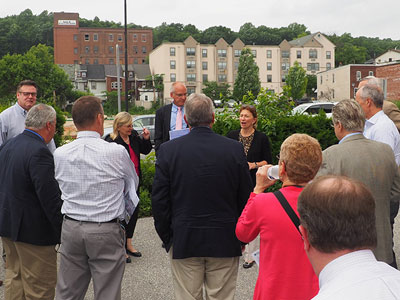
While businesses, buildings, and infrastructure form the foundation of a main street, a dedicated group of individuals can help the main street to further flourish.
Considerations
Municipal Participation
The ongoing relationship between the main street organization(s) and the municipality should be determined. Municipalities may oversee the organization, may provide funding, or serve on the board for external organizations. Alternatively, the main street organization can operate entirely independently from the municipality.
Cost
The cost of forming a main street program and supporting organization, hiring any part time or full-time staff, and implementing programs have to be considered. Determining priorities and strategies can help keep costs within established limits, as can starting small and building momentum over time.
Transparency
Transparency in decision making and implementation is important to any main street organization. Information on activities and decisions should be shared on a routine basis through multiple means, such as public meetings, public notices, press releases, social media, website information, and routine attendance at community meetings to share updates.
Consensus Building
To ensure multiple viewpoints are heard and expressed in a main street organization, and that the loudest voice or personal interest does not lead the decision making process, organizations should continuously strive to build consensus among their members. Regular processes and procedures should facilitate consensus building.
Conflicts of Interest
When selecting members for a main street organization, consideration should be given to handling conflicts of interest. Property or business owners may make decisions that are best for their individual business, and not for the full main street. Procedures should be established to avoid and minimize conflicts of interests.
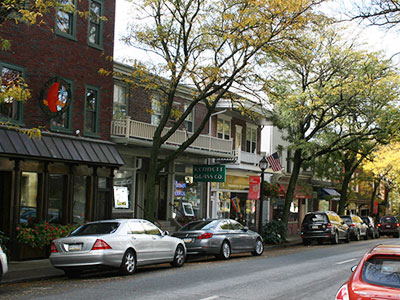
Historic Kennett Square started as a National Main Street Organization and now serves as the economic development organization for Kennett Square Borough and Kennett Township. Both municipalities provide funding directly to HKS. HKS is also supported by member businesses, organizations, and private donors.
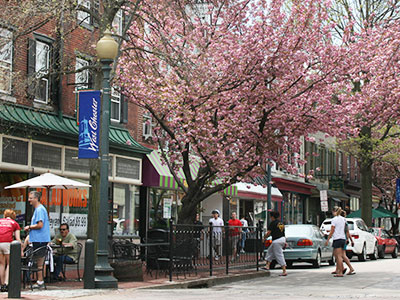
The West Chester BID is paid for by an annual assessment equitably shared by all commercial properties in the BID district and contributions from the borough and the West Chester Downtown Association. The BID serves the West Chester business community through marketing, event hosting, and other work.
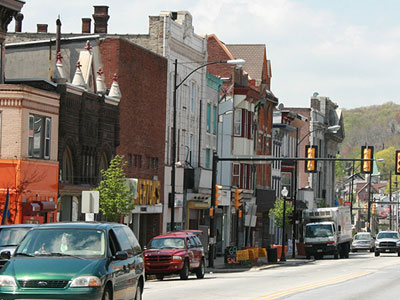
The Coatesville 2nd Century Alliance promotes businesses, redevelopment, economic development, partnerships, and planning in the City of Coatesville. It is funded by a collaboration between the private sector and the Chester County Department of Community Development.


